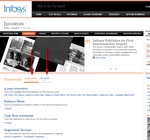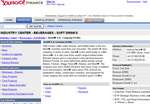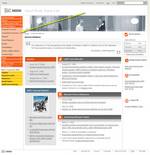In the world of Investor Relations web sites, there is an ongoing tug-of-war between the investor’s desire for more information, the regulations and requirements regarding that information, and the company’s need to preserve some information as private. So, while we should and will continue to find more ways to provide more information, perhaps another goal should be to make the information already provided more useful.
Infosys
Infosys Technologies Ltd. (NASDAQ: INFY) is a global IT and consulting company that generates over $4 billion in revenue. Four billion dollars in U.S. dollars, that is. And, therein lies the rub. As a global company Infosys boasts of offices in India, China, Australia, the Czech Republic, Poland, Canada, Japan and the UK. In particular, Infosys has strong ties to India. So, why just show accounting for U.S. investors?
Infosys provides an array of financial information on their IR web site. What makes that information even more usable for more even more investors is that the information can be viewed by either Indian GAAP or by US GAAP. Doing so provides not only a benefit to investors who can now select the information they want according to what they are most comfortable with, it also provides the company the benefit of showing an apples to apples comparison to either companies that operate in such a way as to only follow Indian GAAP or US GAAP.
Although a savvy, dedicated, experienced analyst could make such comparisons and calculations themselves, the same is not true for many investors. Often, even sophisticated investors don’t understand all the nuances of US GAAP let alone, of both US and Indian GAAP. For example, an Indian investor researching several companies for investment, including Infosys might like to compare some line on the balance sheet with another company. If Infosys provided only US GAAP numbers, the investor might not make a relevant comparison to a company that provided Indian GAAP numbers, and thus, Infosys might lose out on a good investor. The same situation, of course, would apply to an American Investor who might be doing a similar comparison should Infosys report only Indian GAAP numbers.
Presumably, Infosys is required to calculate both sets of numbers, or simply feel it is in their best interest to do so. They are not unique in this respect. However, some companies use the dual set of numbers by creating separate reports and then mailing the one that matches the investor’s address or request. This, obviously, robs both the investor and the company of the benefits of having already compiled two sets of numbers. Other companies might package both sets of reports together, much like multi-language instruction manuals often have English instructions followed by French Instructions, for example. Although this method allows the investor access to both sets of information, many investors might simply disregard the additional information as duplicate information provided for multi-lingual purposes, thus negating the benefits again.
However, with the dynamic nature of an IR web page, the clear cut choice via a simple link immediately informs an investor that he or she has access to two sets of information and they can choose to either only use the set that interests them, or use both for whatever reason.
By taking an extra step with their IR site, Infosys provides not necessarily any more information than your average company’s Investor page, but information that is potentially more usable and friendly.




